Stripper for removing insulation from wires: rules for selecting a tool for stripping cables and wires
The work of an electrician involves stripping conductors, for which they use both improvised tools - a construction knife or pliers, and special pliers.
We recommend using a stripper to remove insulation from wires, as only it guarantees the accuracy and precision of the cut. The range of cleaners is extensive, so we will try to understand the features of the most popular types.
The content of the article:
What is a stripper for?
If you decide install a socket, change the equipment in the electrical panel or extend the electrical cable, you will need to strip the ends of the wires, that is, remove the insulation. This is exactly what a stipper is designed for - a hand tool shaped like ordinary pliers.
Literally, “stripper” is translated from English as “stripper,” which quite accurately defines its purpose.
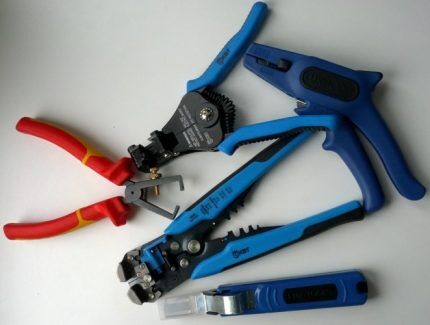
Previously, knives were used to strip the braid, but it was extremely inconvenient to work with them, and the result was not always satisfactory: the cores could be damaged or their diameter could be reduced, which subsequently negatively affected the quality of the electrical wiring.
The use of a stripper minimized the risk of damage to the wires, and the process itself began to take less time.
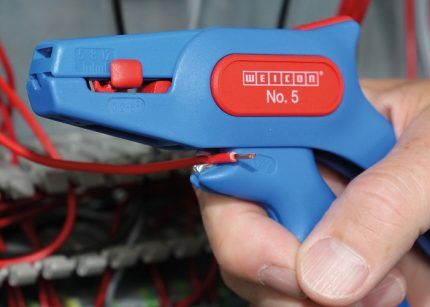
The main advantage of a stripper over the same construction knife is maximum protection of single- or multi-core wire. Now you don’t need to worry that the blade will accidentally cut the current-carrying wire - the tool is equipped with length and diameter limiters.
Brief overview of the model range
If we analyze stripping tool, produced by various manufacturers, you can see that there is no specific division into any categories. All strippers are hand-held electrical tools, but they can differ greatly in shape, size, and function.
Household and industrial wire strippers are usually divided into 3 groups according to the degree of automation:
- mechanical, requiring additional adjustment;
- semi-automatic, partially customizable;
- automatic, requiring no adjustment.
For the most part, these are a kind of pliers or wire cutters with isolated handles and two “lips” that move due to the hinge that holds them together. On the “lips” there are holes of various diameters or knives, with the help of which the cable braid is removed.
There is no strict boundary between the categories, just as there is no single design for the insulation biting mechanism. Examples of popular types:
It is not possible to list all the types - this is a huge range from a small device that fits in the palm of your hand to a compact machine that continuously works in production. But cleaners that are convenient to carry in a tool box, comfortable to hold in one hand and, if necessary, can be adjusted to cut various materials remain popular. type of cables.
But do not forget to take into account that in addition to universal models, there are many special clamps - for fiber optics, internet cable, power wires, copper wires, etc. However, for household chores it is better to purchase universal ones - inexpensive and multifunctional.
Recommendations for choosing a tool
Manufacturers usually do not write in the technical specifications whether the model is mechanical or automatic. However, they indicate whether the basic parameters are adjusted, as well as what cross-section or diameter the tool is designed for.
Let's consider the main criteria that you need to rely on when choosing a manual stripper.
Criterion #1 – maximum/minimum cable diameter
In order not to buy a tool “for all occasions,” you need to determine in advance what type of wires you most often have to deal with. Perhaps this is a power cable, with which there is still a lot of work to be done in connection with the renovation or redevelopment of the apartment, or an 8-core twisted pair cable for the Internet. Accordingly, we also take into account the diameter of the wire.

The diameter scale indicated by the manufacturer for selection may vary, for example, from 0.13 mm to 90 mm. If you only work with home electrical wiring, then it is reasonable to choose a stripper designed for a diameter of 1.5-2.5 mm. A professional tool usually has a wider range.
Criterion #2 – availability of replaceable knives
Typically, a tool with monolithic sharpened “lips” is not able to replace the cutting equipment, since the working part is the main mechanism. But more complex devices consist of a large number of parts that can be replaced if necessary.
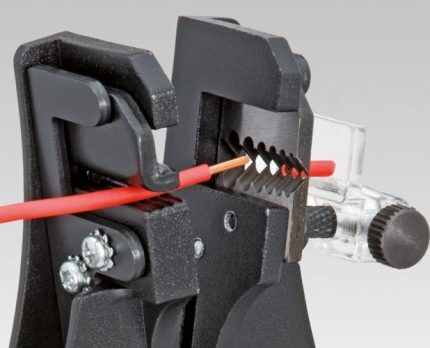
Replacement knives look different: it can be a pair of blades with a fastening screw or a full-fledged cutting head that connects to the handles with a hinge mechanism.
You should know that for domestic use you do not need to purchase expensive equipment with replaceable knives (which cost on average 600-1000 rubles), it is easier to immediately buy new pliers.
Criterion #3 – adjusting the diameter and depth of cut
The ability to adjust is very important, since the quality of the cut and the integrity of the exposed wires depend on it. Many electricians refuse automatic tools in favor of mechanical ones, because they do not trust the devices and are accustomed to independently installing or selecting the necessary parameters.
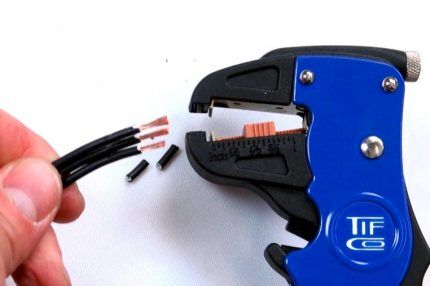
To adjust the depth, some types of strippers have a limiter installed - a small plastic or metal part that fixes the cores in a certain position. The wire simply cannot be inserted beyond the limiter, so the cut is carried out strictly according to the specified depth, for example, 10 mm.
Let's look at how to work with an adjustable tool. As a sample - the simplest wire cutters.
If maximum accuracy is required, purchase an automatic machine or give preference to a stripper for stripping insulation with a set of holes for different diameters.
Criterion #4 – additional features
Some strippers are multifunctional, that is, removing polymer insulation is one of the purposes, perhaps the main one. For example, many pliers, even automatic ones, often have a small blade. It is used to cut the wire to the required length before stripping it.
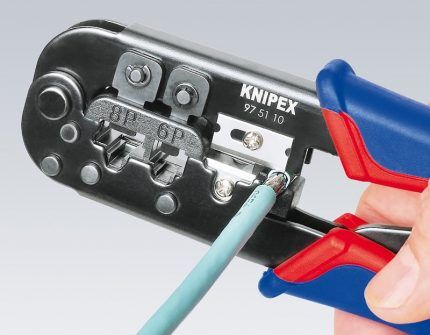
Some manufacturers have gone further and equipped the tool with voluminous handles, from which, if desired, you can take out any devices - from scissors to a corkscrew. Of course, a simple installer does not need such technical delights; experienced craftsmen love a simple but reliable tool.
And multifunctional devices, as you know, break down much faster, and most of the built-in devices are most often not needed.
Criterion #5 – best producer
Wire stripping pliers are produced by both well-known manufacturers and numerous Chinese companies that do not particularly care about product quality.Of course, branded products are stronger, more reliable and more accurate, and the point here is not in the promotion of the brand, but in the quality of production.
It is known that German-made instruments undergo rigorous testing. To make the same pliers, strong hardened alloys are used, and the insulation is checked in special voltage baths.
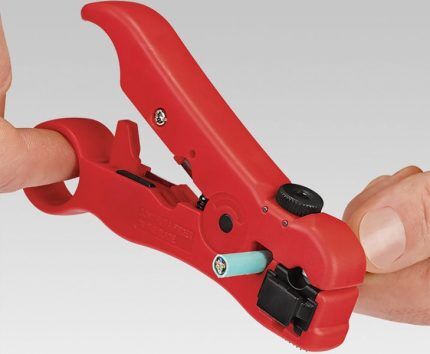
Safety when working with conductive conductors comes first, so it is better to purchase an expensive tool with a manufacturer’s warranty than to rely on the reliability of an inexpensive stripper “without family or tribe.”
Popular and proven brands: FIT, HAUPA, JTC, KING TONY, Knipex, SHTOK, TOPEX.
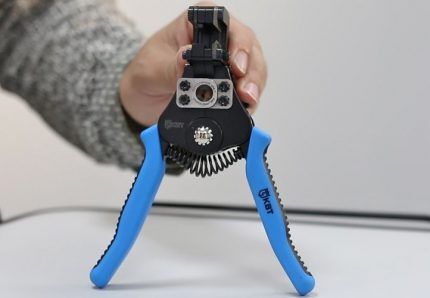
The cost of equipment for stripping insulation depends on the brand and specifics. The average price of a good household tool is 600-1500 rubles. Please note that cheap models are attractive only by their price; good cutting quality or reliability of the knives is out of the question.
We also recommend reading our other article, where we examined in detail various methods of stripping wires of insulation. More details - go to link.
Conclusions and useful video on the topic
Review of strippers tested from personal experience:
Detailed overview of popular models:
Practical video review:
Choosing a tool for electrical work is a purely individual matter.However, there are criteria without analyzing which it is simply impossible to purchase a stripper: technical characteristics, application features, ease of use.
Advice from familiar electricians is also taken into account, but only on the condition that they are experienced, qualified craftsmen, and not amateurs who just happened to install a couple of sockets.
If you have experience using a stripper in practice, please share your advice with those who are just learning to use such a tool. Leave your comments and ask questions in the block below.




About the best manufacturer, it seems to me, is somewhat far-fetched - the operation is so simple that any “noname” can handle it.
Good afternoon, Egor.
There is nothing far-fetched - a year ago, for example, German analysts involved in the mounting tool market appreciated the popularity of strippers.
The surveyed audience of craftsmen (not hobbyists or home craftsmen) helped build the top gadgets, focusing on indicators of functionality, ergonomics, and practicality. The last question was the assessment of cost against the background of other qualitative factors.
The winner is the WEICON Super No. 5 stripper. It is the best selling. But the main thing is that there are no Russian or world analogues.